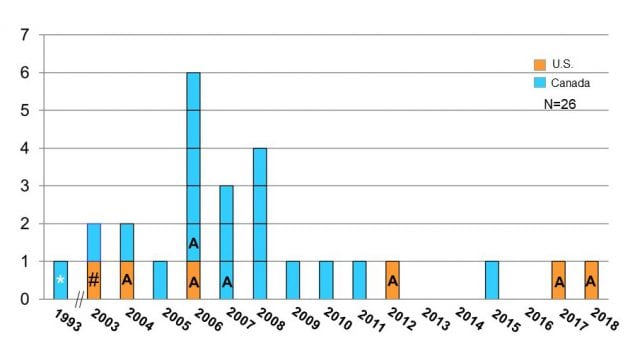BSE in North America
Through August 2018, BSE surveillance has identified 26 cases in North America: 6 BSE cases in the United States and 20 in Canada. Of the 6 cases identified in the United States, one was born in Canada; of the 20 cases identified in Canada, one was imported from the United Kingdom (see graph below).

Key: A-Atypical strain of BSE, #-Imported, Canada to US, *-Imported, UK to Canada
This figure illustrates the 26 BSE cases identified in North America, of which 7 were atypical BSE cases and 19 were classic BSE cases. The only classic BSE case identified in the United States was imported from Canada.
Strong evidence indicates that classic BSE has been transmitted to people primarily in the United Kingdom, causing a variant form of Creutzfeldt-Jakob disease (vCJD). In the United Kingdom, where over 1 million cattle may have been infected with classic BSE, a substantial species barrier appears to protect people from widespread illness. Since vCJD was first reported in 1996, a total of only 231 patients with this disease, including 3 secondary, blood transfusion-related cases, have been reported worldwide. The risk to human health from BSE in the United States is extremely low.
On August 29, 2018, the U.S. Department of Agriculture (USDA) announced a confirmed atypical, H-type case of bovine spongiform encephalopathy (BSE) in a six-year-old mixed-breed beef cow in Florida. USDA reported that this animal never entered the food supply and at no time presented a risk to human health. See the USDA noticeexternal icon.
There have been six cases of BSE identified in the United States: Alabama (2), California (1), Florida (1), Texas (1), and Washington (1).